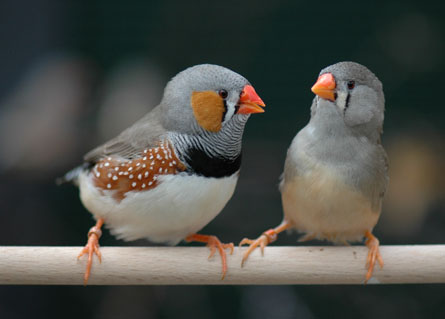Her cheatin’ heart might be inherited from dad.

A study of infidelity among hundreds of captive zebra finches shows that philandering tendencies can be in part inherited, says Wolfgang Forstmeier of the Max Planck Institute for Ornithology in Seewiesen, Germany. The study also reveals a partial link between male and female philandering genes that may help explain how female infidelity evolves, Forstmeier and his colleagues say online June 13 in Proceedings of the National Academy of Sciences.
Just why infidelity arises in females of apparently monogamous species has ruffled feathers among biologists for years. Philandering is easy to explain for males: More quick flutters in the shrubbery mean more offspring in the next generation. But that explanation doesn’t work so well for females: They often produce the same number of youngsters regardless of whether there’s one father or a dozen. And infidelity can have downsides for straying ladies, such as extra childcare duties because a cuckolded male is slacking off on his parenting, Forstmeier says.
An idea proposed 24 years ago, but barely tested, suggests that there doesn’t have to be any benefit to philandering females. They may simply inherit “cheating genes” that arose among male ancestors who did benefit by playing the field.
So female cheating may just be a side effect of the enormous benefit males derive from spreading their seed as widely as possible.
The new finch study “is very, very good,” says evolutionary biologist David Westneat from the University of Kentucky in Lexington. “I am still a bit skeptical that this will be of widespread importance, but we definitely need to consider this hypothesis about genetic correlations more seriously than before.”
Testing the correlation by-product idea has been very difficult, because doing a proper experiment requires knowing an awful lot about animals’ private lives. Tests in insects, which don’t have the same kind of long-term pair bonds, found a connection between male and female genetic tendencies to mate a lot in only one out of four cases, Forstmeier says.
Captive zebra finches offered the possibility of a better test. Researchers filmed and monitored paternity for five generations of birds, for a total of 800 males and 754 females. The researchers switched many of the chicks from their original nests and determined that nature, not nurture, was influencing finch sexual behavior. And the scientists painstakingly documented who mated with or rebuffed whom: Forstmeier himself watched about 1,000 finch courtships on video. “It never got really boring,” he says.
His coauthor Katrin Martin watched multiple thousands of encounters.
While male and female infidelity genetics may be linked, says Andrew Cockburn of the Australian National University in Canberra, he’s not convinced of the by-product explanation for females, that they always suffer. “Another explanation of a strong positive correlation is that extrapair mating is beneficial to both sexes,” he says. And in theory, strong selection on females to be faithful could just as easily spill over in males and rein in philandering.
In any case, he says, females of different species, such as the fairy wrens Cockburn studies, may find different benefits from extrapair mating, like upgrades in genes for the chicks. “The problem is to determine the relative importance of these mechanisms,” he says, “not to assume that there is a single explanation that can be extrapolated across all species.”






